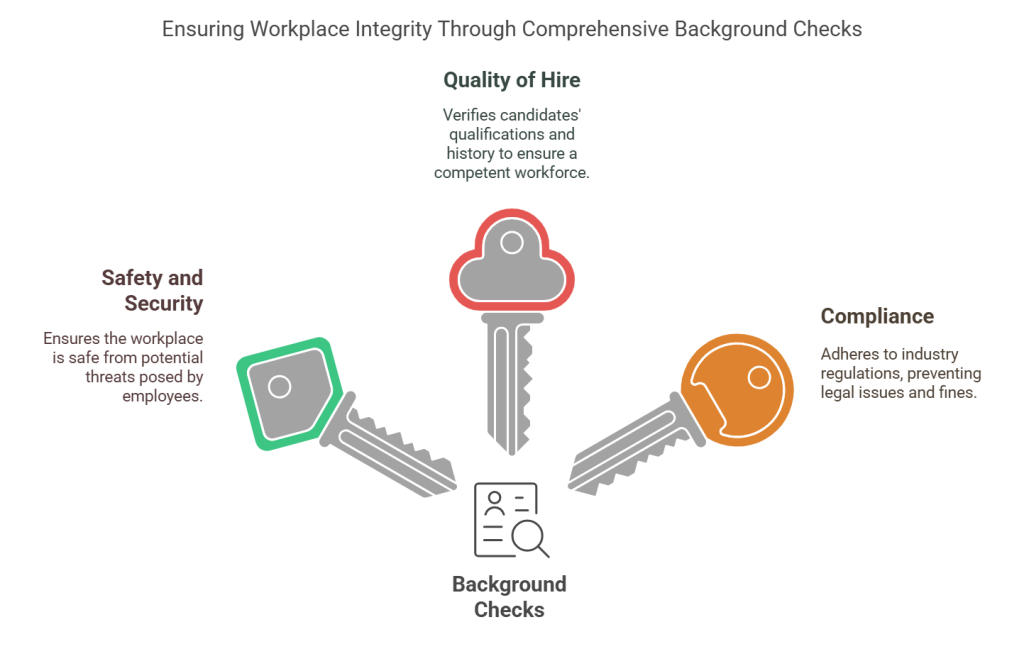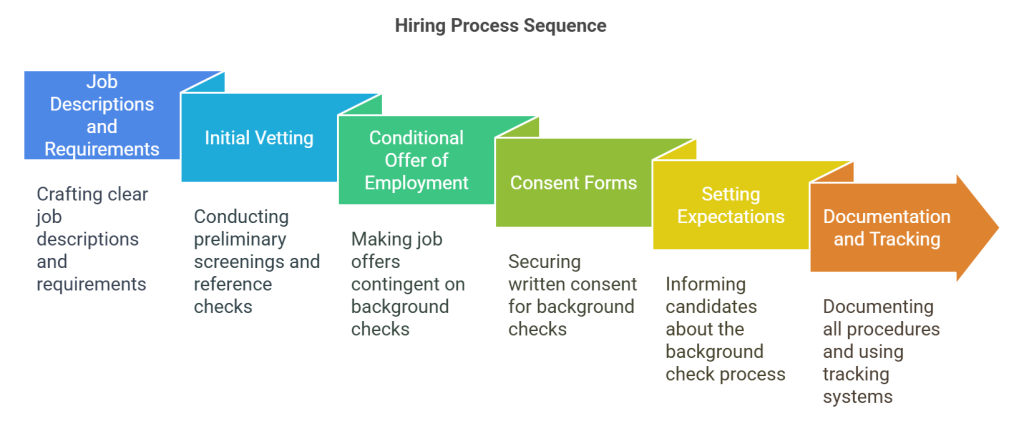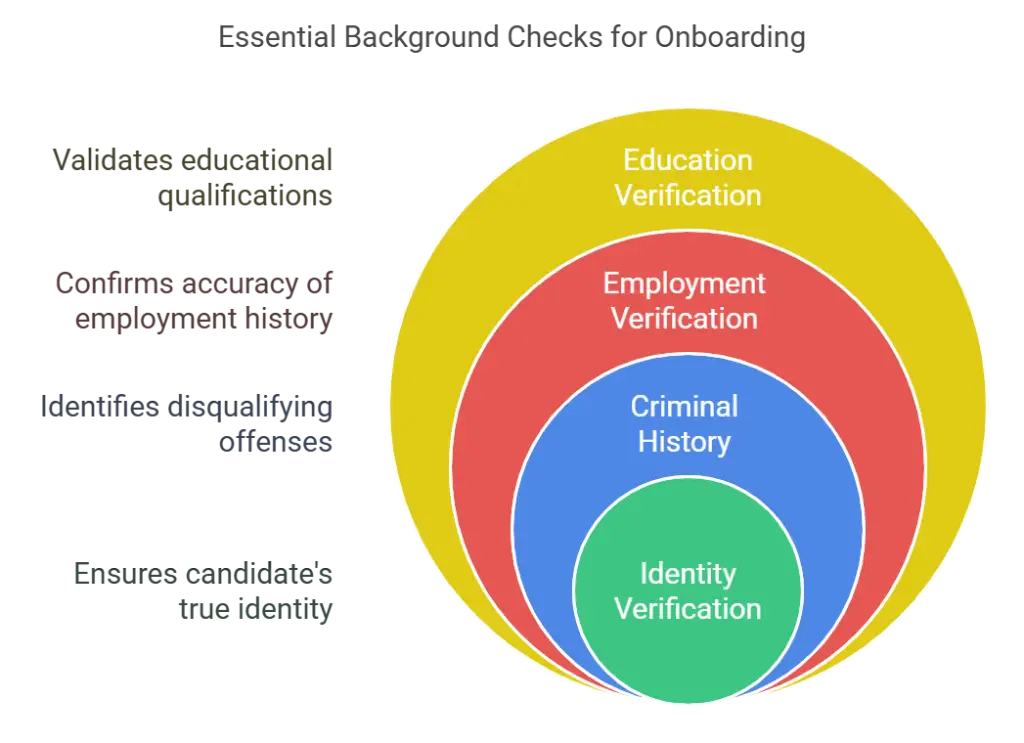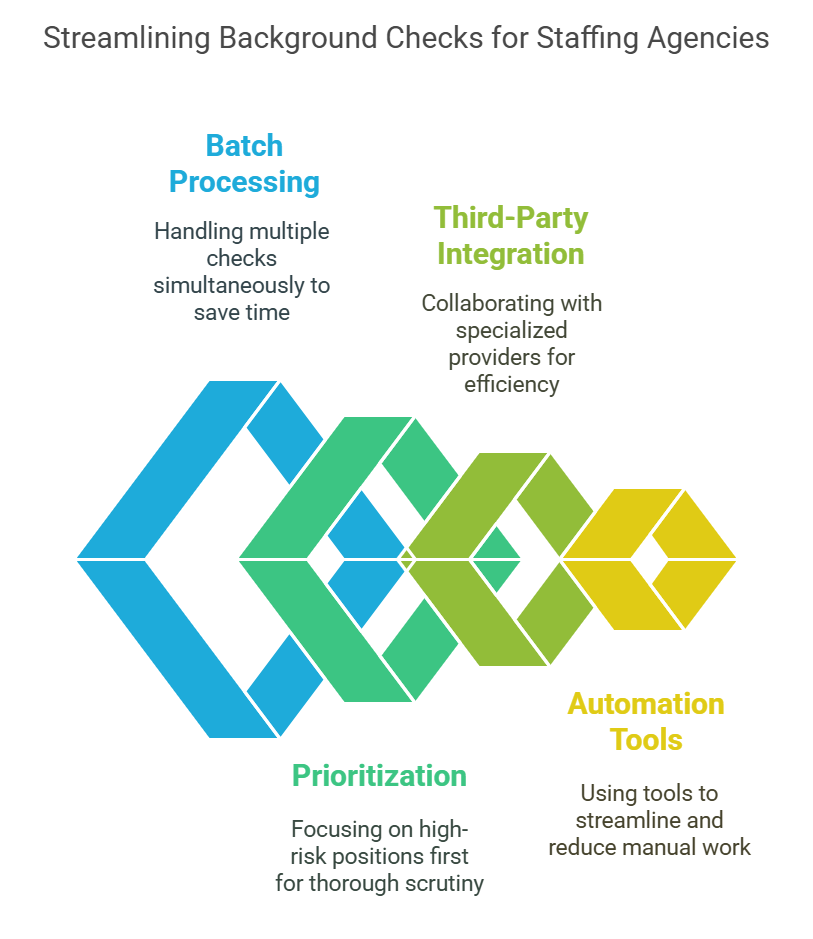Hiring new employees is an exciting yet challenging phase for any organization. The onboarding process is crucial as it sets the stage for a new hire’s experience and success within the company. Among the many steps involved, performing thorough background checks is vital to ensure new hires' safety, security, and reliability. This comprehensive guide will outline how to seamlessly integrate background checks into your onboarding process, ensuring a smooth transition for the employer and the new employee.
Key Takeaways
- A comprehensive onboarding process that includes background checks is crucial for setting the stage for mutual success for both employees and employers.
- Conducting background checks ensures safety, quality, and legal compliance, reducing risks associated with hiring candidates with disqualifying histories.
- Integrating background checks should begin with clear communication at the pre-offer stage, continue through the post-offer with conditional offers and consent forms, and culminate in thorough checks tailored to job requirements.
- Reviewing background check results with consistency and fairness ensures informed and equitable hiring decisions, maintaining trust and transparency throughout.
- Avoid pitfalls such as inconsistent policies and delays by standardizing procedures, safeguarding candidate information, and utilizing automation tools for efficiency.
Introduction
Hiring new employees is more than just filling a vacancy; it's about setting the stage for mutual success. To get it right, the onboarding process must be thorough and efficient, laying out all the essentials from the get-go. A core part of this is integrating background checks to ensure you bring in trustworthy, qualified individuals who fit your organization's needs well.
So, what exactly is onboarding? Think of it as the structured path that guides new hires from "Welcome aboard!" to "I got this!" It involves everything from administrative paperwork to job training, cultural assimilation, and performance expectations. Done correctly, a solid onboarding process boosts employee engagement, retention, and productivity.
But there's a catch. Before investing in training and development, you must confirm you're investing in the right person.
To be sure, we agree that we are not looking for the perfect candidate. What we want are individuals who are the right fit for the given open role. This means identifying candidates who have the skills and potential to excel in the position, even if they don't check every single box. It's about finding the right match between the candidate's abilities and the demands of the role. Ultimately, our goal is to hire and onboard candidates who will thrive in their positions and contribute positively to the company's success.
That's where background checks come in. This article will guide you through weaving these checks seamlessly into your onboarding process, tailored for various industries like staffing agencies, healthcare, transportation, retail, and more. By following our insights, you'll ensure that your new hires are capable but also trustworthy and compliant with industry-specific regulations.
EXPERT INSIGHT: The onboarding process is often viewed as separate from the overall employee experience. However, a deeper look reveals that it is a crucial component that significantly impacts both individuals and companies. It sets the tone for the new hire, giving them a glimpse of what's to come. The relationship with a company begins the moment a recruiter reaches out to a candidate. Additionally, it allows companies to 'nip potential issues in the bud' by identifying risky and unfit hires early on. Integrating background checks into the onboarding process, as you will see, is essential to seamlessly incorporating the entire onboarding experience into the broader employee journey. - Emile Garcia, SHRM-SCP, CHRP, CHRBP
Importance of Background Checks in the Onboarding Process
Let's face it: the hiring process isn't just about finding the most skilled candidate. It's about finding someone trustworthy, reliable, and safe for the role and the organization. This is where background checks come into play, serving as a crucial building block in onboarding.

Safety and Security
When we talk about safety and security, it's about keeping the workplace physically safe and safeguarding the company's reputation. Background checks are key to understanding the integrity and history of your new hires. Imagine skipping this step and discovering later that your new employee has a history of violent behavior or fraud; it's a nightmare scenario that no business should face. Background checks help mitigate these risks, ensuring that the new team members won't threaten the company's environment or assets.
Quality of Hire
Background checks are instrumental in ensuring you're hiring quality candidates. It’s not just about having the necessary qualifications on paper but confirming that these qualifications and past experiences are legitimate. A thorough background check can reveal discrepancies that might go unnoticed until too late. Verifying a candidate’s employment history, education, and other credentials reduces the chances of hiring someone who misrepresented themselves. This leads to a more reliable and competent workforce, enhancing overall productivity.
Compliance
Lastly, let's touch on compliance. Different industries have varying regulations when it comes to hiring, especially in sectors like healthcare and transportation, where the stakes are incredibly high. Conducting proper background checks can result in hefty fines and legal troubles. For instance, healthcare organizations must ensure that employees have the necessary licenses and are not involved in malpractice. Similarly, the transportation sector requires checks for driving records and compliance with Department of Transportation (DOT) regulations. Conducting these checks is not just best practice; it's a legal necessity that protects the company from potential lawsuits and compliance issues.
Integrating background checks into your onboarding process might feel like another hurdle, but it’s a critical step that pays dividends in the long run by ensuring safety, quality, and compliance.
Steps to Integrate Background Checks in the Onboarding Process

Pre-Offer Stage
It's essential to lay a strong foundation starting with the pre-offer stage. This phase sets expectations and communicates the importance of background checks from the start.
Job Descriptions and Requirements
First off, ensure your job descriptions are crystal clear. This means crafting a job title that succinctly reflects the role, outlining what success looks like in the position, and listing relevant skills and competencies required. Typically, job descriptions should also include details about working conditions, schedules, and any travel requirements. Additionally, in today's evolving work environment, it's important to specify whether the job is office-based, remote, or offers a hybrid option. Providing this information helps attract the right candidates and sets clear expectations from the start.
Include that background checks are a mandatory part of the hiring process. This transparency sets the tone and manages candidate expectations early on. Think of it as a heads-up, letting potential hires know what's in store and reducing surprises.
Initial Vetting
Before extending any offers, initial vetting can give you a solid head start. Conduct preliminary screenings like reference checks. These act as an early filter to gauge a candidate's suitability. Ask targeted questions that help you assess their past performance and reliability. For example, inquire about their previous roles, work ethic, and any red flags you should know. This step doesn't replace a full background check but adds an extra layer to your vetting process.
Addressing these aspects during the pre-offer stage creates a streamlined, transparent process that aligns with legal and organizational standards. You’re laying the groundwork for a more effective and seamless background check integration, easing the journey for you and the candidate.
Post-Offer, Pre-Onboarding
Once you've identified the ideal candidate and extended a job offer, it's time to transition into the pre-onboarding phase. The final vetting occurs at this stage, ensuring you have all the necessary information before fully committing to the new hire. Here are the crucial steps:
Conditional Offer of Employment
It's standard practice to make job offers contingent upon completing background checks. When you communicate the job offer to the candidate, clearly state that the offer is conditional. This means their future employment is dependent on the results of various checks. This transparency keeps the process honest and sets appropriate expectations.
Consent Forms
Before diving into the background checks, secure written consent from the candidate. Legally, you cannot perform background checks without the candidate's permission. Typically, this involves signing a consent form that outlines what specific checks will be conducted. Ensure the language is clear and straightforward to avoid any confusion or potential legal issues.
Setting Expectations
Inform the candidate about the timeline and steps involved in the background check process. This helps manage their expectations and minimizes anxiety or impatience, ensuring they remain engaged and informed. A well-informed candidate is more likely to cooperate and understand delays or additional requirements.
Documentation and Tracking
Document all procedures, permissions, and communications with the candidate. This ensures transparency and accountability. Utilize onboarding software or a tracking system to manage this documentation effectively. This step is crucial for compliance and keeping a clear audit trail.
By incorporating these steps post-offer and pre-onboarding, you create a clear, compliant roadmap that ensures you and the candidate are on the same page. This helps prevent surprises, ensure a smoother onboarding process, and foster a sense of security and trust from the very start.
Additional Research: To ensure a comprehensive onboarding process, it is essential to integrate multiple forms of qualitative data, including interviews, observations, documents, and audio-visual materials. This approach helps develop a robust understanding of the case and its context, as seen in the case study of Eastwood City Council's onboarding process. This study examines the onboarding process for newly elected city councilors, highlighting the importance of integrating various data sources and ensuring transparency and ethical considerations. See Case Study: Onboarding City Councilors
Conducting the Background Check
Conducting background checks is where the rubber meets the road in the onboarding process. It’s a straightforward yet critical step that can make or break the integrity of your hiring pipeline.

Criminal History
This is a non-negotiable check, especially in industries requiring high trust, such as healthcare, finance, and childcare. You must identify any disqualifying offenses that could pose risks to your organization. Don’t just look at the severity but the relevance of the crime to the role.
Employment Verification
Confirm the details provided by candidates about their past employment. Inaccurate or misleading employment history can indicate deeper issues with a candidate’s reliability.
Education Verification
Validate the candidate’s educational qualifications. Whether it’s a high school diploma or a PhD, confirming these credentials is crucial to ensure they meet job requirements.
Identity Verification
This check is essential to confirm the candidate is who they claim to be. Identity fraud isn't unheard of, and verifying this can save you from potential future headaches. For more information on the importance of identity verification, check out this resource.
Third-Party Services
Most businesses entrust this task to third-party services experienced in conducting comprehensive background checks. These services handle the heavy lifting, from running criminal history checks to verifying employment and educational backgrounds. By partnering with reputable firms, you reduce the risk of errors and ensure a thorough vetting process. For more detailed insights on using third-party services, refer to this SHRM toolkit.
By meticulously conducting these checks, you're not just filling a slot—you’re fortifying your workforce with reliable and trustworthy talent.
Reviewing Results
Once you've gathered the background check results, it's time to evaluate them in the context of the job requirements. This isn't just a box-ticking exercise; careful assessment here can be crucial for hiring the right.
First off, measure the results against the job's specific needs. For example, if you're hiring for a financial position, you might be particularly vigilant about past fraud or financial misconduct misdemeanors. On the other hand, certain roles might prioritize clean driving records or unblemished customer service history.
Consistency is key. Apply the same evaluation criteria across all candidates to ensure fairness. The same offense should have the same implications regardless of who committed it. This fosters a sense of fairness and protects your organization against potential claims of discrimination or bias.
Discrepancies might arise, and addressing these directly with the candidate is important. Approach these discussions with an open mind. There might be legitimate explanations or even errors in the background check data. Providing candidates a chance to explain discrepancies can maintain a fair and transparent process while giving you a more complete picture of the applicant.
Reviewing results might seem tedious, but it's essential for making informed and equitable hiring decisions. Consistency, fairness, and thorough evaluation can help ensure successful and safe hires, ultimately contributing to a positive onboarding experience.
Best Practices for Smooth Integration
To make the background check stage as smooth as possible for both you and your new hires, there are a few key practices to adopt:
Communication
First and foremost, keep your candidates informed. Timely and transparent communication about each step of the background check process helps reduce anxiety and builds trust. Let them know what checks are being conducted, why they are necessary, and how long it might take. Frequent updates can help manage expectations and keep things moving forward.
Documentation
Maintain meticulous records, from the candidate’s consent to the final results of the background checks. This is not just about covering your legal bases; well-organized documentation ensures everyone involved in the onboarding process can access the necessary information. It simplifies the follow-up process if any questions or discrepancies arise. Additionally, ensure that these records are securely stored to maintain confidentiality.
Automation Tools
Consider leveraging technology to streamline your background check processes. Use comprehensive onboarding software that offers background check integrations. Automation tools can handle repetitive tasks efficiently, reducing the chances of human error and speeding up the overall process. Look for features like reminders, customizable workflows, and secure data handling.
Compliance with PBSA Standards
Ensure your background checks align with the standards set by the Professional Background Screening Association (PBSA). This international association provides guidelines and best practices to ensure the reliability and legality of background checks. Adhering to these standards ensures you’re compliant with industry regulations and adds more credibility to your hiring process.
Adhering to these best practices will create a more efficient, transparent, and compliant background check process that benefits the organization and the new hire.
Industry-Specific Considerations
Staffing Agencies
Managing background checks for staffing agencies presents a unique challenge due to the high volume of candidates. Given this industry's competitive nature and tight timelines, efficiency and scalability are key. Agencies should develop a systematic approach to background screening that allows for quick yet thorough vetting of multiple candidates simultaneously.
High Volume Screening

- Batch Processing: Implement batch processing to handle multiple background checks at once. This approach can significantly reduce the time required per candidate, ensuring the agency can meet client demands without sacrificing thoroughness.
- Prioritization: Define criteria to prioritize checks for candidates filling higher-risk positions first. This ensures that the most critical placements are scrutinized with utmost care.
- Third-Party Providers: Partner with reliable third-party background check providers specializing in high-volume processing. These providers often offer tailored solutions that integrate smoothly with applicant tracking systems (ATS), streamlining the vetting workflow.
- Automated Tools: Leverage automation tools to expedite the screening process. For instance, automated systems can pre-fill forms, automatically track the status of checks, and notify recruiters of completed evaluations. This minimizes manual workload and reduces errors associated with high-volume operations.
By incorporating these strategies, staffing agencies can maintain a rapid and effective onboarding process, ensuring they efficiently deliver qualified and reliable candidates to their clients.
Healthcare
Precision and vigilance are non-negotiable when integrating background checks into the onboarding process within the healthcare industry. Given the high-stakes environment, where the staff's competency and character directly impact the well-being of patients, several specific considerations must be addressed.
Licensing Verification
One of the primary steps in healthcare background checks is verifying potential hires' medical licenses and credentials. Ensure that they hold valid, up-to-date licenses required for their roles. Verify these through state or national licensing boards to prevent lapses or fraud. This step not only confirms qualifications but protects the institution from liability issues.
Sanctions Checks
Healthcare professionals should also undergo thorough sanctions checks. This involves evaluating whether the candidate has any history of malpractice or disciplinary actions. Referencing databases such as the National Practitioner Data Bank (NPDB) can reveal suspensions, revocations, or other sanctions that could be critical red flags.
Drug Screening
Given the critical nature of healthcare professionals' tasks, drug screening is essential. Ensuring that employees are not under the influence of substances that could impair their performance is crucial for patient safety.
Healthcare-Specific Criminal Checks
These checks should go beyond standard criminal history evaluations by focusing on offenses that could impact patient care. Look for any prior convictions related to abuse, neglect, fraud, or any other crimes that might endanger patients or compromise ethical standards.
References and Employment History
Contact previous employers and supervisors to gather insights on the candidate's performance, behavior, and reliability in past healthcare roles. Direct communication often reveals context that a resume cannot convey.
Ongoing Checks
The healthcare industry demands continuous compliance with standards and regulations, making periodic re-screenings necessary. Establish a protocol for routine checks to ensure ongoing eligibility and adherence to evolving legal and ethical standards.
By implementing these tailored background check procedures, healthcare organizations can significantly mitigate risks and ensure they are hiring trustworthy professionals committed to delivering safe, ethical, and high-quality patient care.
Transportation
Regarding the transportation industry, integrating background checks into the onboarding process is not just a formality; it's a fundamental requirement to ensure the safety and compliance of your operations. Here’s a closer look at the key components you need to consider:
- Driving Records: One of the primary checks involves scrutinizing the candidate’s driving history. This includes verifying any past traffic violations, DUIs, or other infractions that could indicate risky behavior on the road. Ensuring that your potential hire has a clean and reliable driving record is essential, reducing the likelihood of accidents and liability issues.
- DOT Compliance: Compliance with Department of Transportation (DOT) regulations is paramount for commercial vehicle operators. This means checking that the candidate meets all DOT requirements, including medical examinations, drug and alcohol tests, and other mandated qualifications. Failure to do so could result in hefty fines and operational disruptions.
By diligently conducting these checks, you safeguard your operations and build a workforce that meets the stringent standards necessary for the transportation sector. This thorough approach helps maintain a competent and conscientious fleet, ensuring your services run smoothly and safely.
Retail
The stakes around theft and fraud are particularly high in the retail industry. Background checks focusing on criminal history related to theft or fraud are crucial. The retail sector has a high turnover rate, and thus, it's imperative to integrate this screening step seamlessly into the onboarding process.
Employers can mitigate risks associated with dishonest behavior by verifying candidates' criminal records. For instance, examining past misdemeanors or felonies related to shoplifting or embezzlement can offer insights into the candidate’s reliability and suitability for cash handling and inventory management roles. Utilizing third-party services to conduct these specific checks can streamline the process, ensuring it’s both thorough and timely.
Technology
In the technology sector, verifying a candidate's technical skills is paramount. While resumes and portfolios can provide an initial snapshot, background checks ensure the authenticity of the claimed skills and certifications. Begin by pinpointing key technical competencies required for the role. Utilize specialized tests or third-party assessment tools to confirm proficiency in programming languages, system administration, or software development.
Equally crucial is maintaining an unbiased approach. Focus solely on relevant background data to uphold equal opportunity principles. Avoiding biases helps build diverse and competent teams, especially in tech, where varied perspectives drive innovation.
By rigorously verifying technical skills and adhering to unbiased practices, companies can secure highly qualified talent to contribute to technological advancements and organizational objectives.
Hospitality
In the hospitality industry, the focus isn't just on the candidate's skills and qualifications but on their ability to embody the culture and values of your establishment. Integrating background checks into the onboarding process here isn't just about ticking off a list of credentials; it’s about ensuring that new hires are a good fit operationally and culturally.
Customer Service Records
One of the key areas to verify is past employment in customer service roles. The nature of the hospitality industry demands exceptional interpersonal skills and a knack for handling diverse customer needs. Ensure the candidate has a solid track record in customer service. Conducting thorough reference checks with previous employers can provide insights into their ability to manage customer interactions, handle complaints, and deliver high levels of guest satisfaction. This step helps avoid hiring individuals lacking the essential soft skills to thrive in a customer-centric environment.
Cultural Fit
Beyond verifying employment history, assessing the cultural fit of your candidates is paramount. Background checks can be paired with cultural and personality assessments for a holistic view of the candidate's suitability. This may include evaluating their capacity to work in team settings, their adaptability, and their alignment with your organization's core values. It's about more than just avoiding red flags; it's about ensuring that the new hire can contribute positively to the workplace atmosphere and guest experience.
Practical Tips
- Structured Interviews: Incorporate questions that probe into past experiences relevant to customer service and teamwork.
- Behavioral Assessments: Utilize tools that help gauge personality traits and cultural alignment.
- Feedback Loops: Implement feedback sessions from current employees about continually integrating new hires to refine the onboarding process.
By focusing on both customer service records and cultural fit, you can seamlessly integrate background checks into the onboarding process in the hospitality industry. This ensures that new hires possess the requisite skills and are primed to contribute to a positive, cohesive workplace culture.
Common Pitfalls to Avoid
When integrating background checks into your onboarding process, several pitfalls can derail your efforts if not carefully managed. Here are a few to keep an eye on:
- Inconsistent Policies: Standardizing background check policies across all departments is crucial. When different teams have varying criteria or lax implementation, it can lead to both legal challenges and perceptions of unfair hiring practices. Develop a consistent set of procedures and ensure all departments are aligned.
- Privacy Breaches: Protecting the confidentiality of background check information is non-negotiable. Mishandling sensitive data not only violates privacy laws but also erodes candidate trust. Securely store and manage all documentation and limit access to authorized personnel only.
- Delays: Background checks often have the potential to elongate the onboarding process if not managed efficiently. Lengthy delays can frustrate top candidates or even cause them to seek opportunities elsewhere. To mitigate this, streamline your processes, possibly incorporating automation tools, and engage reliable third-party services to ensure timely completion.
By being mindful of these common pitfalls, you can create a more effective and secure onboarding process that respects candidate privacy, maintains consistent standards, and operates smoothly.
Conclusion
Ensuring that background checks are seamlessly integrated into your onboarding process is critical for your new hires' safety, security, and overall reliability. As outlined, robust background checks can help you avoid costly hiring mistakes, protect your organization's reputation, and comply with legal and regulatory standards.
By making these checks a standard part of your hiring process, from the pre-offer stage to post-offer and onboarding, you set a high bar for the quality and trustworthiness of your employees. Clear communication, documentation, and efficient tools can streamline this integration, making it less of a chore and more of an opportunity to enhance your onboarding protocol.
For business owners, HR professionals, and recruiters, the time and effort invested in thorough background checks are undoubtedly worth it. It ensures that every team member meets the job requirements and aligns well with the company's values and culture.
Taking the steps to prioritize proper background checks during onboarding sends a strong message: your organization is committed to excellence, compliance, and a safe working environment. These efforts will pay off in the form of a more cohesive, reliable, and productive team, setting the stage for your company's long-term growth and success.
So take the plunge, integrate these processes seamlessly, and watch your organization's onboarding experience improve, benefiting you and your new hires.
Additional Resources
- How Automation is Transforming Employee Screening
- Overcoming Common Screening Challenges
- Michigan Background Check Laws: A Guide for Businesses and HR
- Maryland Background Check Laws: What Employers Need to Know
- Integrating Background Checks into the Onboarding Process
- The Benefits of Post-Employment Screening for Employers
- Everything You Need to Know About Form I-9
- The Importance of Background Checks for Church Staff and Volunteers
- In-house Background Screening vs Outsourced Background Screening
- How To Move To A New Background Screening Provider
- Do Warrants Show Up on Your Background Check?
- Rideshare Driver Background Checks: What You Need to Know
- Understanding the Right to Work Share Code: Everything You Need to Know
- Commercial Transportation Fraud Prevention
- Comprehensive Guide to Background Checks in New Mexico
- Pennsylvania Background Check Laws: Your Complete 2024 Guide
- Massachusetts Background Check Laws: A Comprehensive Guide
- How to Dispute Public Records in Alaska: A Step-by-Step Guide
- Top Conferences for the Background Check Industry
- The Role of Background Checks in Preventing Workplace Violence
Still have questions?
Get in touch with our team today for a personalized demo and discover how our tailored volume pricing and packages can drive results for your business!
How useful was this page?*
Note: your comments are anonymous. We use them to improve the website. Do not include any personal details.
Visit our FCRA Compliance Tool or leave a message here if you need a response.
From the blog Explore the GCheck Content Hub

How Long Do Background Checks Take for Government Jobs? Timeline Expectations for 2026
6 Jan, 2026 • 20 min read
Driver Qualification File Requirements: Your Complete DOT Compliance Guide
6 Jan, 2026 • 18 min read
Healthcare Background Screening Costs: 2026 Budget Planning Guide for Medical Facilities
30 Dec, 2025 • 23 min readThe information provided in this article is for general informational and educational purposes only and should not be construed as legal advice or a substitute for consultation with qualified legal counsel. While we strive to ensure accuracy, employment screening laws and regulations—including but not limited to the Fair Credit Reporting Act (FCRA), Equal Employment Opportunity Commission (EEOC) guidelines, state and local ban-the-box laws, industry-specific requirements, and other applicable federal, state, and local statutes—are subject to frequent changes, varying interpretations, and jurisdiction-specific applications that may affect their implementation in your organization. Employers and screening decision-makers are solely responsible for ensuring their background check policies, procedures, and practices comply with all applicable laws and regulations relevant to their specific industry, location, and circumstances. We strongly recommend consulting with qualified employment law attorneys and compliance professionals before making hiring, tenant screening, or other decisions based on background check information.


